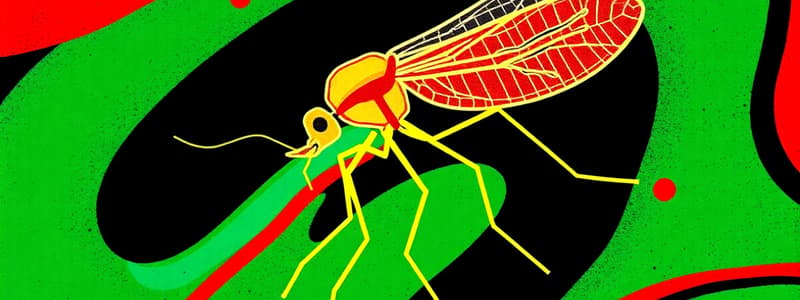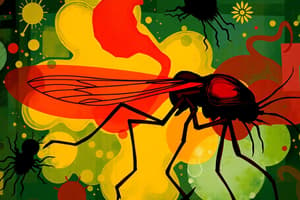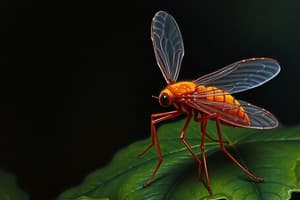Podcast
Questions and Answers
Which Plasmodium species is responsible for the majority of malaria deaths?
Which Plasmodium species is responsible for the majority of malaria deaths?
- Plasmodium malariae
- Plasmodium ovale
- Plasmodium vivax
- Plasmodium falciparum (correct)
What is the significance of chloroquine in malaria treatment?
What is the significance of chloroquine in malaria treatment?
- It kills the parasites causing malaria. (correct)
- It acts as a vaccine against malaria.
- It enhances the immune response.
- It prevents mosquito bites.
Which cellular structure in Apicomplexans plays a role in motility?
Which cellular structure in Apicomplexans plays a role in motility?
- Microtubule corset
- Alveolin network
- Apicoplast
- Glideosome (correct)
Which of the following contributions does sickle cell anemia provide in relation to Plasmodium infection?
Which of the following contributions does sickle cell anemia provide in relation to Plasmodium infection?
Which Apicomplexan genus is not associated with malaria?
Which Apicomplexan genus is not associated with malaria?
What is one characteristic of the Plasmodium lifecycle?
What is one characteristic of the Plasmodium lifecycle?
What is one function of the rhoptries in Apicomplexans?
What is one function of the rhoptries in Apicomplexans?
How does Plasmodium evade the immune system?
How does Plasmodium evade the immune system?
Flashcards
Plasmodium
Plasmodium
A genus of parasitic protozoa that causes malaria.
Malaria species
Malaria species
Four species of Plasmodium infect humans, causing malaria.
Plasmodium falciparum
Plasmodium falciparum
The most deadly species of Plasmodium, responsible for most malaria deaths.
Sickle cell anemia resistance
Sickle cell anemia resistance
Signup and view all the flashcards
Chloroquine
Chloroquine
Signup and view all the flashcards
Malaria pathology
Malaria pathology
Signup and view all the flashcards
Apicoplast
Apicoplast
Signup and view all the flashcards
Epidemiology of malaria
Epidemiology of malaria
Signup and view all the flashcards
Study Notes
Plasmodium and Malaria
- Malaria is caused by different Plasmodium species
- Malaria pathology is linked to immune evasion via sequestration
- The Plasmodium lifecycle is complex
- Plasmodium infects specific human host cells
- Sickle cell anemia can result in resistance to Plasmodium
- Chloroquine kills parasites, but some have developed resistance
Apicomplexans
- Apicomplexans are a group of single-celled eukaryotes
- Six genera infect humans
- Plasmodium (causes malaria)
- Cryptosporidium (causes diarrhea)
- Isospora (causes diarrhea)
- Cyclospora (causes diarrhea)
- Toxoplasma (causes neurological pathology)
- Babesia (causes rare zoonotic disease)
Apicomplexan Cell Organelles
- Apicoplast: a metabolic organelle (derived from endosymbionts) found in most but not all
- Inner Membrane Complex (IMC): a series of membrane sacs found under the plasma membrane
- Proteins complexes for gliding motility and invasion
- Cytoskeleton (including microtubule corset, alveolin network, and actin)
- Secretory organelles (micronemes, rhoptries, dense granules)
Malaria Epidemiology
- Plasmodium falciparum causes most deaths (99.7% of African cases, 97% worldwide)
- Plasmodium vivax is usually uncomplicated, causing 75% of cases in the Americas and ~50% of SE Asia cases
- Plasmodium ovale is usually uncomplicated (<1% of cases)
- Plasmodium malariae is usually uncomplicated (<1% of cases)
- 94% of malaria cases and deaths occur in Africa
- More than half the global malaria cases happen in 6 African countries
- Nigeria (25%)
- Democratic Republic of the Congo (12%)
- Uganda (5%)
- Cote d'Ivoire, Mozambique, and Niger (4% each)
Decline in Malaria (Since 2010)
- There were an estimated 228 million cases of malaria worldwide in 2018
- 405,000 people died from malaria in 2018, with 76% of these deaths occurring in children under 5
- Vector control and improved access to medicine has resulted in 93 million fewer cases and 590,000 fewer deaths each year
Malaria Pathology
- Malaria is characterized by bouts of fever, occurring every other day
- The fevers are linked to the synchronized release and invasion of parasites from red blood cells
- Complicated/severe malaria includes severe anemia, cerebral malaria (causing coma and death), caused by P. falciparum
Infected Red Blood Cells
- Infected red blood cells change shape, developing knobs
- Knobs contain the parasite protein PfEMP1
- Only P. falciparum has PfEMP1 and forms knobs
Cytoadhesion, Sequestration, and Occlusion
- Cytoadhesion causes red blood cell changes
- PfEMP1 makes infected red blood cells sticky to endothelium
- This causes red blood cell and vessel occlusion/sequestration which prevents effective immune response
Sequestration and Cerebral Malaria
- Massive sequestration of the parasite in the brain leads to cerebral malaria
- Blocked capillaries in the brain swell, leading to hemorrhage, coma and death
- A direct link exists between the parasite's immune evasion mechanisms and the human pathology
Plasmodium Lifecycle
- The Plasmodium lifecycle involves a mosquito vector and a human host
- Sporozoites are injected into the skin by infected mosquitos
- Sporozoites travel to the liver, invade liver cells
- Merozoites are released, infecting red blood cells
- Merozoites develop into schizonts
- Merozoites replicate, bursting out of the red blood cells, infecting new cells
- Some infected red blood cells become gametocytes, which are transmitted to the mosquito
- Fertilization occurs in the mosquito's gut
- Oocysts develop, releasing sporozoites into the salivary glands, ready to infect a new host
Mosquito Feeding and Injections
- Mosquitoes feed from blood vessels
- Saliva contains anti-clotting chemicals and other compounds to prevent blood clotting from the blood vessel
- Infected mosquitoes' saliva also contains Plasmodium parasites
In Vivo Imaging
- Fluorescent Plasmodium sporozoites can be observed passing through the mosquito proboscis and into the dermis
Liver Stage Invasion and Development
- Sporozoites reach the liver within an hour of infection.
- They invade liver cells, differentiate into schizonts
- Schizonts rupture, releasing merozoites into the blood stream
- This event takes 7 days and causes 20,000-fold parasite growth.
Merozoites Replication (in red blood cells)
- Merozoites enter red blood cells within a parasitophorous vacuole
- They replicate in the ring stage
- They develop into schizonts
- They rupture, releasing new merozoites to infect more red blood cells
Gametocytogenesis
- Merozoites differentiate into gametocytes (male-micro and female-macro)
- These gametocytes are needed to continue the life cycle and infect another host
- The mechanisms for sexual development in parasites are not well understood
Chloroquine
- It is an antimalaria drug
- It's mechanism of action prevents parasite heme breakdown into hemozoin
- Malaria parasites have developed resistance to chloroquine
Malaria Resistance and Sickle Cell Anemia
- Sickle cell anemia is caused by a mutation in beta hemoglobin, causing red blood cells to become sickle shaped under low oxygen tensions.
- These sickle-shaped cells are more likely to be cleared by the immune system
- Malaria resistance in sickle-cell carriers is due to reduced parasite growth in these cells
Studying That Suits You
Use AI to generate personalized quizzes and flashcards to suit your learning preferences.




